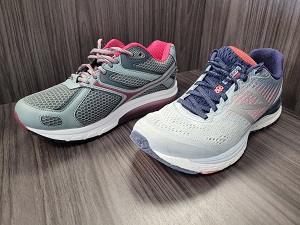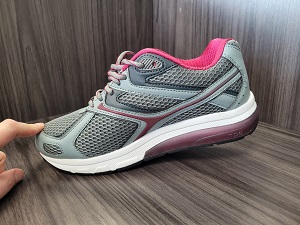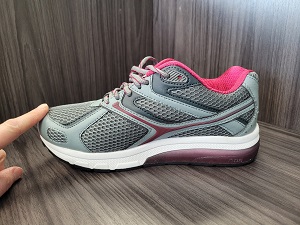
Finding the Right Shoe for Your Feet
Finding the right shoe can be more in depth than you may think. In addition to finding the correct size, there are multiple factors to consider when selecting a shoe.
Type of Shoe
The type of shoe is important to consider. Different shoes will have different features depending on what activity you are doing in the shoes.


If you are strictly walking or standing in the shoes, a walking shoe is a good option. The wide base of support helps with stability to reduce the chance of injury and providing support from side to side. A walking shoe tends to have a feature called a rocker sole at the front of the shoe. The front of the shoe curves up to help your foot as your push off the back leg. It reduces pressure at the ball of the foot, and helps your muscles from getting overworked.
For any type of intense exercise, such as running, plyometrics and HITT workouts, a running shoe
is a great option. It is a lighter shoe than the walking shoe, which helps prevent your feet and legs from tiring during the exercise. The sole of the shoe tends to have more cushioning, which improves the shock absorption. They also tend to have more cushioning around the heel, which keeps the heel in place while moving around.
Sport specific shoes provide features that help with performance and/or prevent injury. For example, soccer and baseball cleats have large bumps on the bottom to improve the grip on the slippery surfaces. Some of these sport specific shoes may not have the level of support to protect the foot from mechanical injuries. In these cases, custom orthotics or over the counter inserts may be beneficial to wear as well.
Amount of Support
There are shoes that have different levels of support, such as neutral, stability and motion control. Knowing how your foot behaves will help you choose the correct level!
A neutral shoe will have the same level of support around the base of the shoe. It keeps the foot level and does not push the foot over to one side. This type of shoe is recommended for those with a high arch, supinated foot (rolling outwards) and most individuals who wear custom made foot orthotics.
A stability shoe contains a harder material on the inside of the shoe base. Because of the softer outside and harder inside, the foot can be pushed outward. This type of shoe is recommended for those with a flat foot, pronated foot (rolling inwards) and for some individuals who have custom made foot orthotics and a severe flat foot. When combining a foot orthotic with a stability shoe, consulting your foot professional is recommended to prevent any overcorrections. An overcorrection can lead to pain to structures higher up, such as the knee and hip.
A motion control shoe contains the most support at the base, but does not push the foot to one side or the other. This type of shoe is recommended for those with a severe flat foot or excessive motion in the foot that needs to be controlled.
Closure
Finding shoes that have laces or Velcro improve the fit compared to slip on shoes. Even if the slip-on shoes feel perfect in the store, the fit can change from day to day and from morning to night. Throughout the day, feet tend to swell, especially by the end of the day. This swelling can change the fit significantly. Also, different socks can provide a different shoe fit every day. Laces and Velcro customize the fit of the shoe through the adjustability, depending on the swelling and socks worn.
Additional Features
There are additional features that can be included on a shoe for various purposes.
For those with very wide feet, there are specialized shoes have extra wide options available, such as 6E. In addition to that, there are shoes that are extra deep. This can be helpful for those with swelling, hammer toes or any other reason where extra room is needed.
Some footwear will have a softer or stretchy area for a bunion. This reduces pressure and rubbing to the bunion, which can be otherwise irritating.
There are many different features to consider when finding the right shoe. For more information about your specific needs, a foot assessment may be recommended.
If you have any questions, feel free to contact us!

You must be logged in to post a comment.